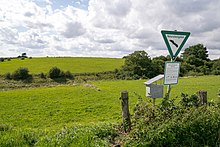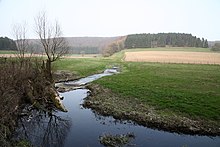Sauertal
Coordinates: 51 ° 35 ′ 33 " N , 8 ° 58 ′ 47" E
The Sauertal nature reserve is located in the area of the city of Lichtenau in the Paderborn district in North Rhine-Westphalia . The 967 ha area was designated as a nature reserve (NSG) by the Detmold district government in 2000 under the code number PB-008. In 2014 the NSG was re-designated by the district council with the Lichtenau landscape plan. Two parts of the nature reserve were designated in 2004 as the FFH area Kalkfelsen bei Grundsteinheim with 6 ha and as a European bird sanctuary (abbreviation bird sanctuary) Egge , whereby only 131 ha of the NSG south of Kleineberg belong to the 7,164 ha large bird sanctuary Egge . The area, which consists of six sub-areas, extends along the river Sauer . The B 68 runs through the area .
description

The Sauertal nature reserve comprises the area of the Kleinenberger Mulde , the Winzenberg and parts of the Sauertal . In the Sauer Valley, the NSG includes areas between Kleinenberg and Lichtenau, between Lichtenau and Iggenhausen and between Grundsteinheim and Ebbinghausen . The NSG borders directly on the nature reserves Schmittwassertal , Sauerbachtal Bülheim and Oberer Kleinenberg .
In the NSG there are extensive wet grassland areas, moors, limestone semi-arid grasslands, poor pastures and forests. Numerous biotope structures in the NSG are evidence of centuries-old forms of cultivation, such as B. Hutewalds and limestone semi-arid grasslands. In the NSG there are naturally flowing sections of the Sauer with flat and steep banks, gravel banks, pools, swallow holes and woody stands that accompany the banks. The Kleinenberger Sauer with its source and sections of various source streams with sources are also in the area. The streams only carry water at times in this karst area . Swamps, small bodies of water, reed beds, sedge reeds and small-scale grassy grass lawns also occur. There are flood channels in the Saueraue. In the protected area there are also forest areas with woodruff beech forests, small floodplain and alder forests. There are also various rock areas with up to 20 high rocks, caves, sinkholes, swallow holes, orchards, head trees, distinctive single trees, groups of trees and hedges in the NSG.
The NSG is a habitat for rare animal and plant species. There are species such as red-backed shrike (Lanius collurio), pond bat (Myotis dasycneme), Brandt's bat (Myotis brandti), Daubenton's bat (Myotis daubentoni), brown long-eared bat (Plecotus auritus), Kingfisher (Alcedo atthis), Red Kite (Milvus milvus), Black Woodpecker ( Dryocopus martius), common woodpecker (Picoides medius), gray woodpecker (Picus canus), black stork (Ciconia nigra), great gray shrike (Lanius excubitor) and eagle owl (Bubo bubo).
Regarding the value of the NSG, the landscape plan writes: "As a linear connecting axis between the forests of the southern Egge Mountains and the Paderborn plateau, the Sauer Valley is of particular importance as a biotope network axis."
Special prohibitions in the NSG
In the NSG, reforestation with non-native deciduous tree species is prohibited, whereby the plant material for the trees must come from the West German mountainous region. But with reforestation, conifers may be added individually, in groups or in groups up to a maximum of 25%. In the NSG, clear-cutting over 0.3 ha per year is prohibited. Hem and Femel cuts are allowed.
Special conservation activities
The Community Conservation - in Bürener country in 1999 filed an application with the NRW Foundation areas to buy in Sauer Valley. In 2000, the district government in Detmold initiated the Sauertal land order procedure with an accelerated consolidation procedure in accordance with Section 91 of the Land Consolidation Act (FlurbG). The Sauer Valley land planning procedure affected 472 hectares of land. The land management system was carried out by the state of North Rhine-Westphalia, the North Rhine-Westphalia Foundation and the Paderborn district. The objectives of the process were: "To transfer ecologically valuable nature conservation areas along the Sauer into public ownership; To avoid disadvantages in terms of agricultural structure, replacement and compensation areas should be provided; Conflicts between agriculture and nature conservation should be eliminated. The optimization of the protection goals should be achieved through suitable forms of management." 113 hectares became the property of the state of North Rhine-Westphalia, 120 hectares to the North Rhine-Westphalia Foundation and 21 hectares to the Paderborn district. The western part of the area was excluded from the purchase and exchange of land. In 2020 the procedure should be completed with the correction of the land register and cadastre. The NRW Foundation took over or bought a total of 144 hectares. The Community for Nature Conservation - in the Bürener Land is responsible for looking after the areas of the NRW Foundation.
See also
literature
- Paderborn district: Landscape plan Lichtenau Paderborn 2014.
Web links
- Nature reserve "Sauertal (PB-008)" in the specialist information system of the State Office for Nature, Environment and Consumer Protection in North Rhine-Westphalia
- World Database on Protected Areas - Sauertal (English)
Individual evidence
- ↑ Detmold district government: Regulatory authority regulation for the “Sauertal” nature reserve in the city of Lichtenau and the Borchen municipality, Paderborn district, dated January 14, 2000. Official Journal for the Detmold administrative region of January 31, 2000, pp. 28–31
- ↑ a b c d e f Paderborn district: Lichtenau landscape plan. Paderborn 2017 p. 12 ff
- ↑ Together with the North Rhine-Westphalia Foundation - The Sauertal Homepage Community for Nature Conservation Project - in the Bürener Land
- ↑ Land regulation procedure Sauertal Homepage Detmold district government
- ↑ SAUERTAL IN THE PADERBORNWO DISTRICT: THE PADER STILL SAUER IS NAME Video of the NRW Foundation on Youtube
- ↑ Sauertal nature reserve near Paderborn Homepage NRW Foundation





